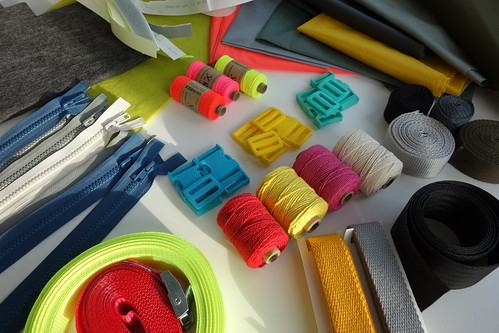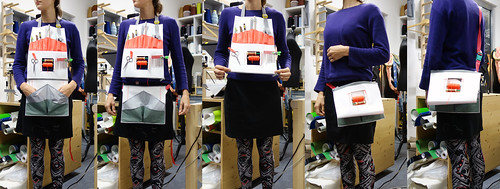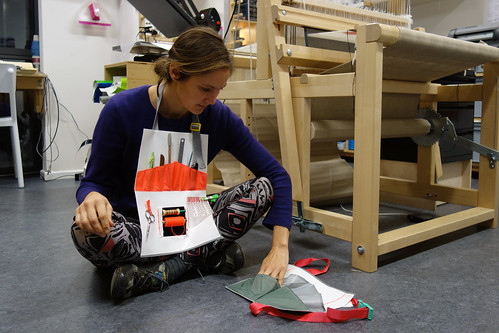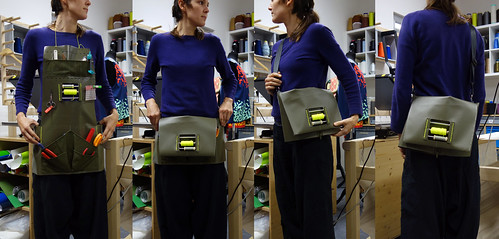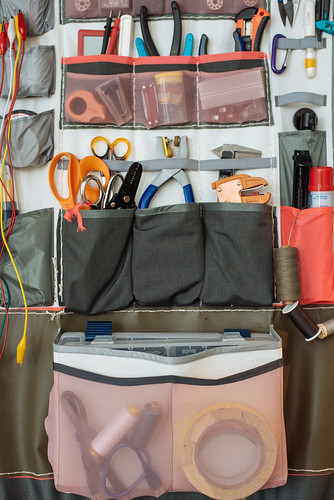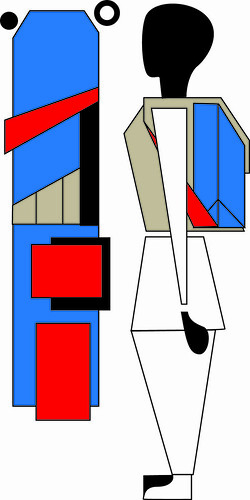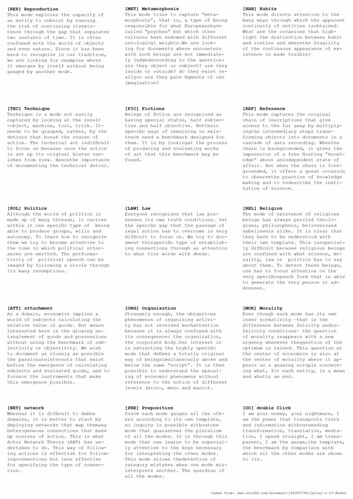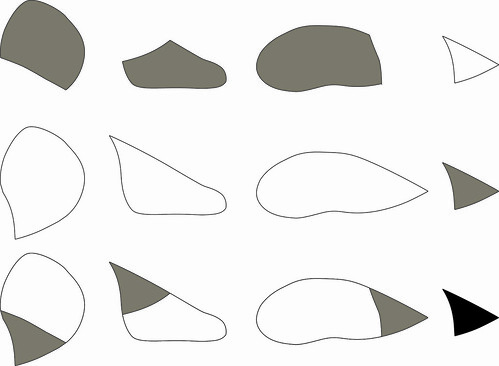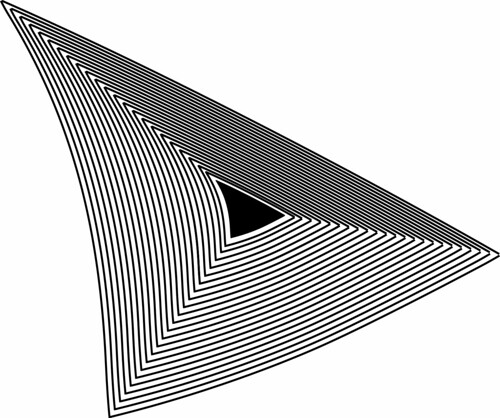Making Discussion (2016)
Building structure from materials of value – an experiment in hands-on discussion
Making Discussion comes from a desire to be able to use my hands to manipulate matter in order to engage in discussions. Not discussion about the form and function of what is being created, but philosophical, political discussions about abstract topics. In particular I was interested in real-time discussions/conversations that normally take place in spoken language, in shared physical space.
To create an opportunity to experiment with this format, I decided to try and design a kind of work outfit for the maker discussor. A shoulder bag intended to be worn as a regular bag, with pouches for foraging, hunting and gathering materials throughout the day. Similarly to how we pick up ideas, collect thoughts, take notes, this bag is a storage container for material ideas. When the maker discussor enters into a discussion, the bag can be transformed into a tool-apron, a work uniform, a discussion costume. The pouches containing the foraged materials are easily accessible and the rest of the apron contains a selection of tools that can be used for working these materials, manipulating them and producing discussion.
For (no)action(no)space I produced five of these uniforms to allow a group of people to hunt and gather material for ideas and then come together to make discussion.
In the nans space at Schloss Solitude people brought in materials to contribute to the discussion and we also collected materials from outside the Schloss. The Making Discussion was lead by a presentation/narrative, which provided content for the discussion, but also tried to lead the discussion into a making trance. Listening to the talk, handling the materials, concentrating on both making and understanding created the experience. The objects in the end didn’t really get to talk, and it was not clear to me if or how they should have a voice. This discussion was more about shared experience. I want to try it again.
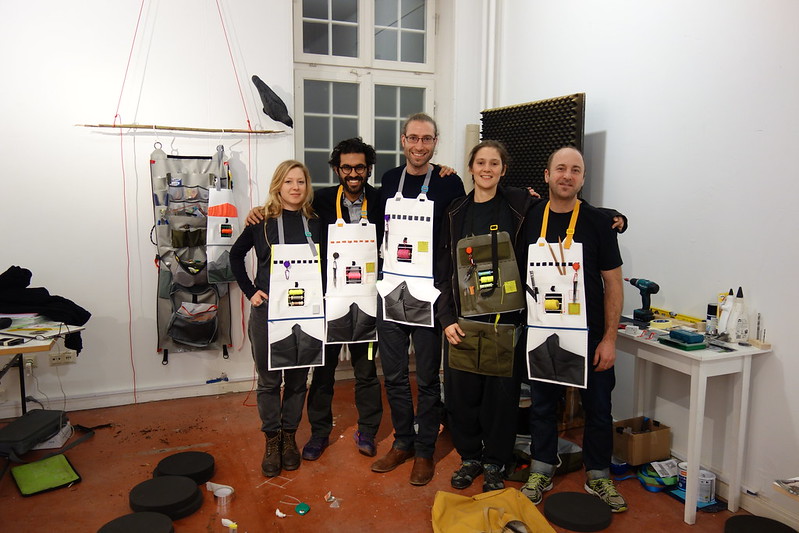
(no)action(no)space
“Siting Around the Same ›Fire‹ in the Digital Age”
>> https://schloss-post.com/siting-around-fire-digital-age/
These are some of the questions that came up for me while planning, making and executing this project:
Can we make with materials as fast as our minds can think? If we have to slow the speed of discussion down to a “makeable” rate, does this change the nature of the discussion? Can we mix makers and talkers in discussion?
Materials are not as abstract, as language. How much influence does the material impose on the conversation?
Sunday December 11th 11-14:00 at (no)action(no)space in Schloss Solitude
Participants are invited to make discussion by building structures from a select palette of materials and tools. The topic for discussion will be introduced in the form of a lecture. The fact that the materials selected for this task reference values that resulted from Bruno Latour’s investigation into our modes of existence, might or might not be important. The tools will be selected for their ability to manipulate and join these materials in a variety of ways and could be unequally distributed among the participants. The discussion will last slightly longer than the lecture, and will end with tea and sweets. Come hungry.
Project page >> http://noactionnospace.org/
Flickr set >> https://www.flickr.com/photos/plusea/albums/72157675729952331
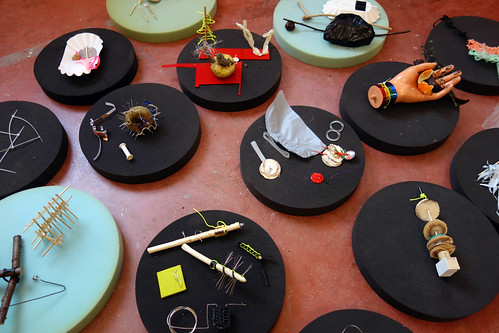
Poster:
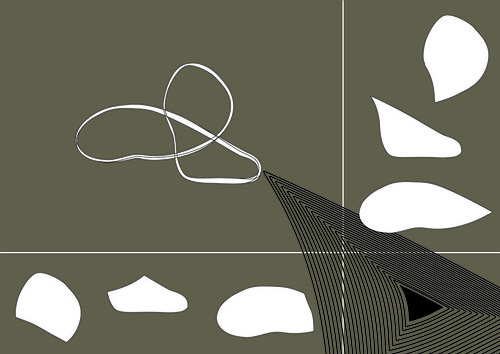
Flickr set >> https://www.flickr.com/photos/plusea/sets/72157675729952331
Making-of: Making Discussion
The following entries are marked by date and trace the development of this project. Trying to collect sources of inspiration, communication and events that took place as this project took shape.
7/12/2016
Second Prototype – „let’s stay Mondrian inspired“
Searching the web for constructivist aprons, I come across the collection of Eldina Begic:
multi-pocket-apron >> http://shop.comradettes.com/product/multi-pocket-apron
manifesto >> http://www.comradettes.com/manifesto
>> http://designobserver.com/article.php?id=28348


6/12/2016
First Prototype
The lower part of the bag/apron contains pouches for gathering/gleaning materials as ideas, inspirations, input for discussing. The upper part of the tool apron contains the tools for discussing with.
Laura: „let’s stay Mondrian inspired“, “the white ground is crucial”…
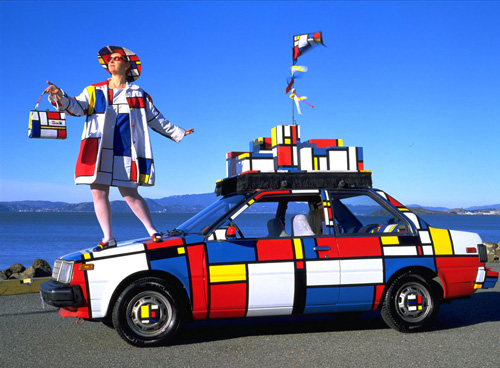
This reminds me of my attempt (and failure) at making the PIFpack inspired by a similar order of lines and colored surfaces…
Constructivist inspired…
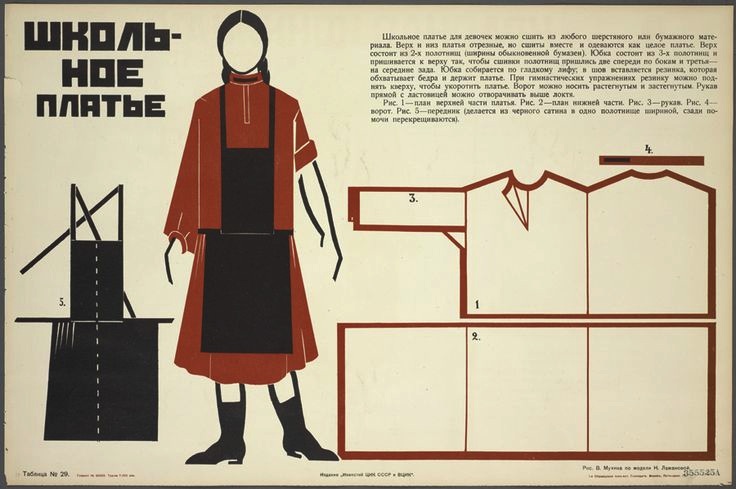
But also because order creates a freedom. Andrea Zittel’s organized, optimized, personal spaces and uniforms – where structure on the outside provides for freedom within.



Digital Publication
Notes from the meeting about the digital? publication to accompany (no)action(no)space…
6/12/2016
(foraged)materials(select)tools
instead of focusing on the selection of materials, i’m now more curating the selection of tools/processes for working with materials/matter.
The selection of materials&tools for the discussion toolkit is becoming more and more an e-textile/kit-of-no-parts toolkit. Through the combination of foraged materials with electrical circuit elements, it somehow proposes to explore making electronic circuits. Or maybe just circuits.
JB: I use this word (manifestation / erscheinung != representation / darstellung) with phenomenology in mind, especially embodiment* & collective embodied cognition/thinking
>> http://www.iep.utm.edu/husspemb/
“motility – make freely and responsively”
Making, the Integrated Circuit:
Gramophone and movies were merely the mechanization of speech and gesture. But the radio and TV were not just the electronification of speech and gesture but the electronification of the entire range of human personal expressiveness. With electronification the flow is taken out of the wire and into the vacuum tube circuit, which confers freedom and flexibility such as are in metaphor and in words themselves.” 1955
Edited by Eric McLuhan & Frank Zingrone “Essential McLuhan” Routledge 1997 ISBN 0-415-16245-9 page 273.
“the wheel
is an extension of the foot
the book
is an extension of the eye
clothing, an extension of the skin,
electric circuitry,
an extension of
the
central
nervous
system”
The Medium is The Massage, Marshall McLuhan p 31-40
Once the environment is conceived as mediated, it ceases to be a passive concept and becomes an active one, as Janine Marchessault has pointed out: “Nature in the new cosmic age of the integrated circuit is profoundly technological and technology is natural”
McLuhan in Space: A Cultural Geography by Richard Cavell
For Virilio, when information becomes the “last dimension of space-time-matter”, and computer-generated virtuality is possible, the “far horizon” (beyond which the human eye could not see) becomes a “trans-apparent horizon” and the “mental image of far distances” yields to “instrumental imagery of a computer that can generate a virtual otherworld, thanks to the computing speed of its integrated circuits” (Virilio 1995:143). With increases in processing power and graphic frame rates, and the advent of portable, personal virtual-environment systems, Virilio observes a change in the speed of history: from long-term to short-tern to “real-term”.
Transforming McLuhan: Cultural, Critical, and Postmodern Perspectives by Paul Grossweiler
Feminists must, she proclaims, unite behind “an ironic dream of a common language for women in the integrated circuit.”
“A Cyborg Manifesto” by Donna Haraway
6/12/2016
Definitions
Definitions taken from Wikipedia and Google:
Intercession
Intercession is the action of intervening on behalf of another.
Synonyms: mediation, intermediation, arbitration, conciliation, negotiation; intervention, involvement; pleading, petition, entreaty, agency; diplomacy
Intercession or intercessory prayer is the act of praying to a deity on behalf of others. In Western Christianity, intercession forms a distinct form of prayer, alongside Adoration, Confession and Thanksgiving.
Transistor
A transistor is a semiconductor device used to amplify or switch electronic signals and electrical power.
Semiconductor
Semiconductor devices can display a range of useful properties such as passing current more easily in one direction than the other, showing variable resistance, and sensitivity to light or heat. Semiconductors can be used for amplification, switching, and energy conversion.
Energy Conversion
Energy transformation or energy conversion is the process of changing one form of energy to another form of energy. In physics, the term energy describes the capacity to produce certain changes within any system, without regard to limitations in transformation imposed.
Relay
A relay is an electrically operated switch. Relays are used where it is necessary to control a circuit by a separate low-power signal, or where several circuits must be controlled by one signal. The first relays were used in long distance telegraph circuits as amplifiers: they repeated the signal coming in from one circuit and re-transmitted it on another circuit. Relays were used extensively in telephone exchanges and early computers to perform logical operations.
4/12/2016
Hunted and Gathered
Materials & Tools spreadsheet >> https://docs.google.com/spreadsheets/d/1VRTYw3eqCRDKbbAfFCZhn_m_OTY8PnszMVn3z0qdlls/edit?usp=sharing
The materials can be hunted and gathered from anywhere at any time. While food shopping in the supermarket you could forage for items that inspire you to build. When visiting a friend, ask them to give you something to include in your materials library. On your walks, gather whatever sparks interest, and go hunting for what you want to have.
JB: Varda’s The Gleaners and I is notable in another regard, as well. In a film about gleaning, Varda recognizes that she is a gleaner. “I’m not poor, I have enough to eat,” says Varda, but she points to “another kind of gleaning, which is artistic gleaning. You pick ideas, you pick images, you pick emotions from other people, and then you make it into a film.”
>> https://en.m.wikipedia.org/wiki/The_Gleaners_and_I

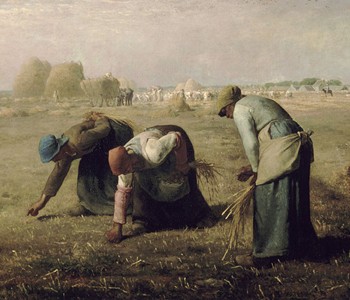
Foraging pouch

Apron for tools
>> http://vintagecraftsandmore.com/tag/sew-apron/
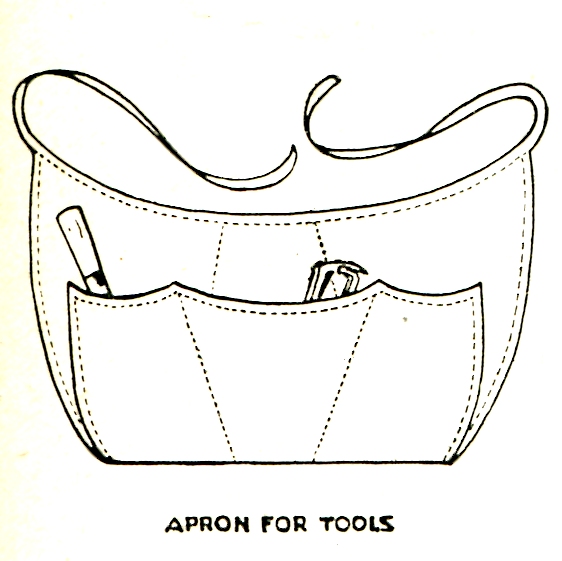
Fire Hose shop apron
>> http://www.duluthtrading.com/store/product/shop-apron-improved-fire-hose-bib-apron-85021.aspx
Printed apron
>> http://www.stephaniewilkinson.co.uk/swapron.htm
Hunt & Gather Apron Bag by Natalie Purschwitz
>> http://canadiandesignresource.ca/fashiontextiles/apron-bag/

Thing to Thing Project >> http://canadiandesignresource.ca/exhibitions/thing-to-thing-project/

Unisex hairdresser belt tool bag / Hairdresser holster/ Hair stylist apron / Hairdresser gift
>> https://www.etsy.com/listing/128862205/unisex-hairdresser-
belt-tool-bag
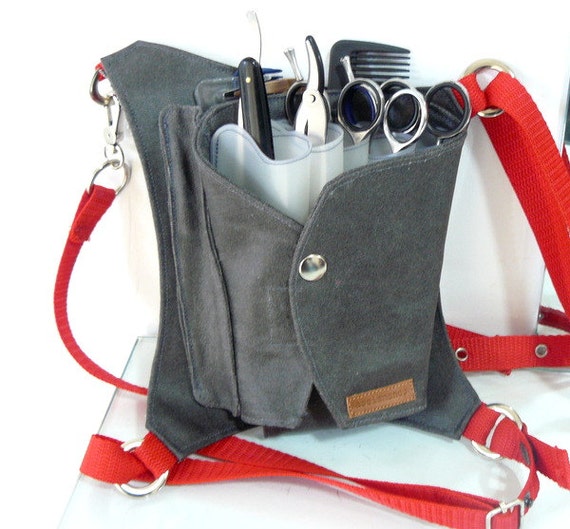
Alibaba

Snap Bag
>> http://wuitoki.altervista.org/portfolio/snap-bag/

Apron Bag
>> http://wuitoki.altervista.org/portfolio/the-apron-bag/

Design-A-Bag Competition 2013 >> http://www.arsarpel.com/future-designers-awards/
AMUDO
A bag that can transform from a handbag to a backpack or sling bag.
>> http://www.coroflot.com/lkong/Amudo-State-changing-Bag

Apron Tool Bag
>> http://www.red-dot.sg/de/online-exhibition/concept/?code=829&y=2013&c=12&a=2?code=829&y=2013&c=12&a=2
This tool storage bag unzips into a work apron in which tools can be carried for convenient access during repair work.


1923 Flapper Era Aprons Dust Caps Sewing Reference Book DIY Prohibition Clothing
Skirt Aprons

Gathering apron
>> https://www.vermontapron.com/garden-aprons
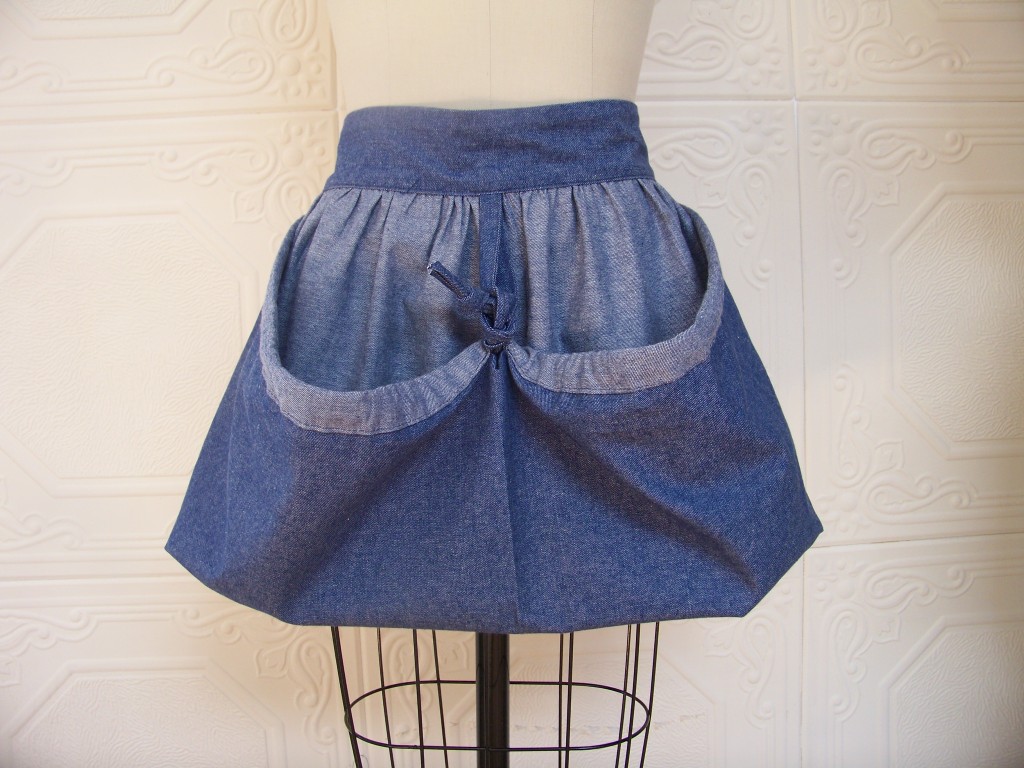
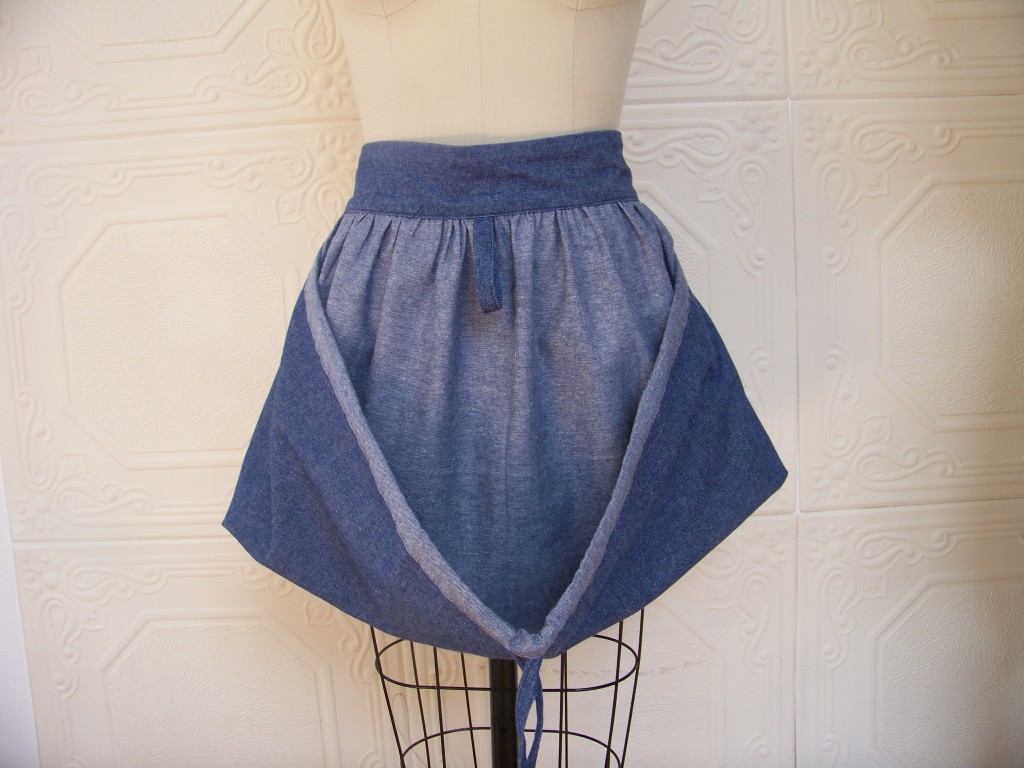
Berry picking apron pattern
>> http://sewinghappyplace.blogspot.de/2011/09/berry-picking-apron-tutorial-from-1944.html
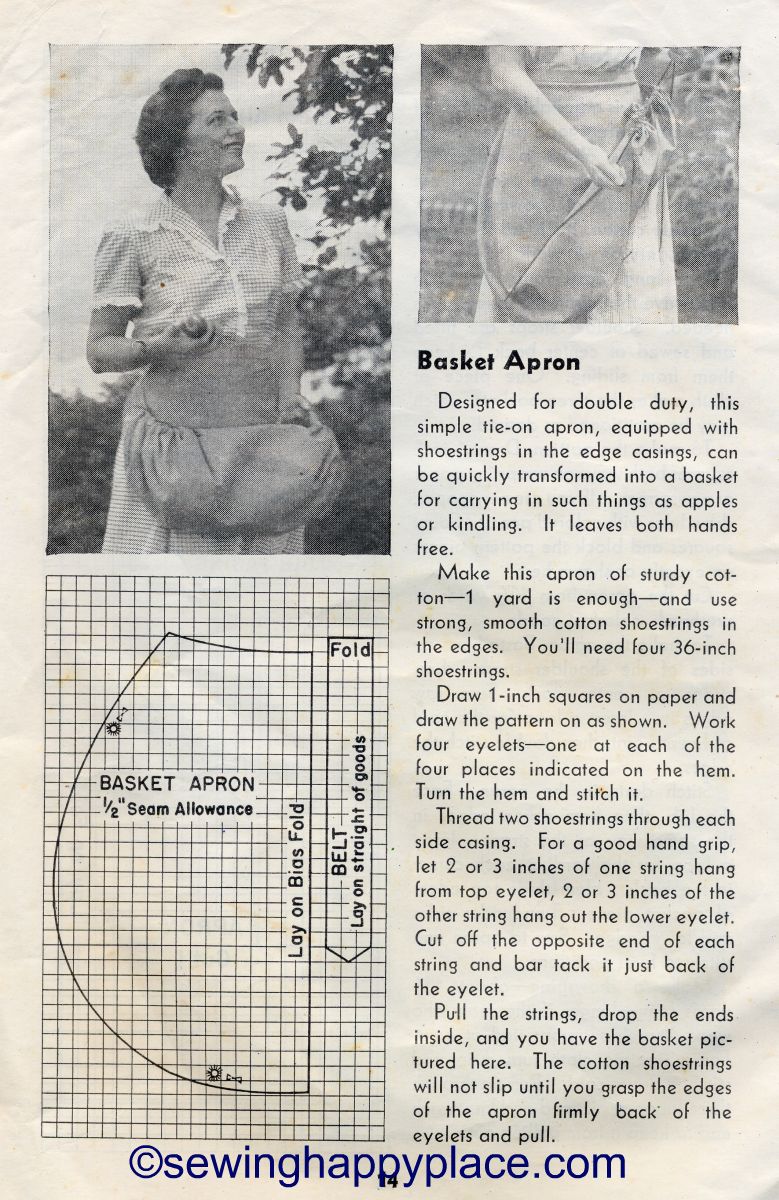
Kneeling apron pattern
>> http://sewinghappyplace.blogspot.de/2011/09/be-kind-to-your-knees-kneeling.html
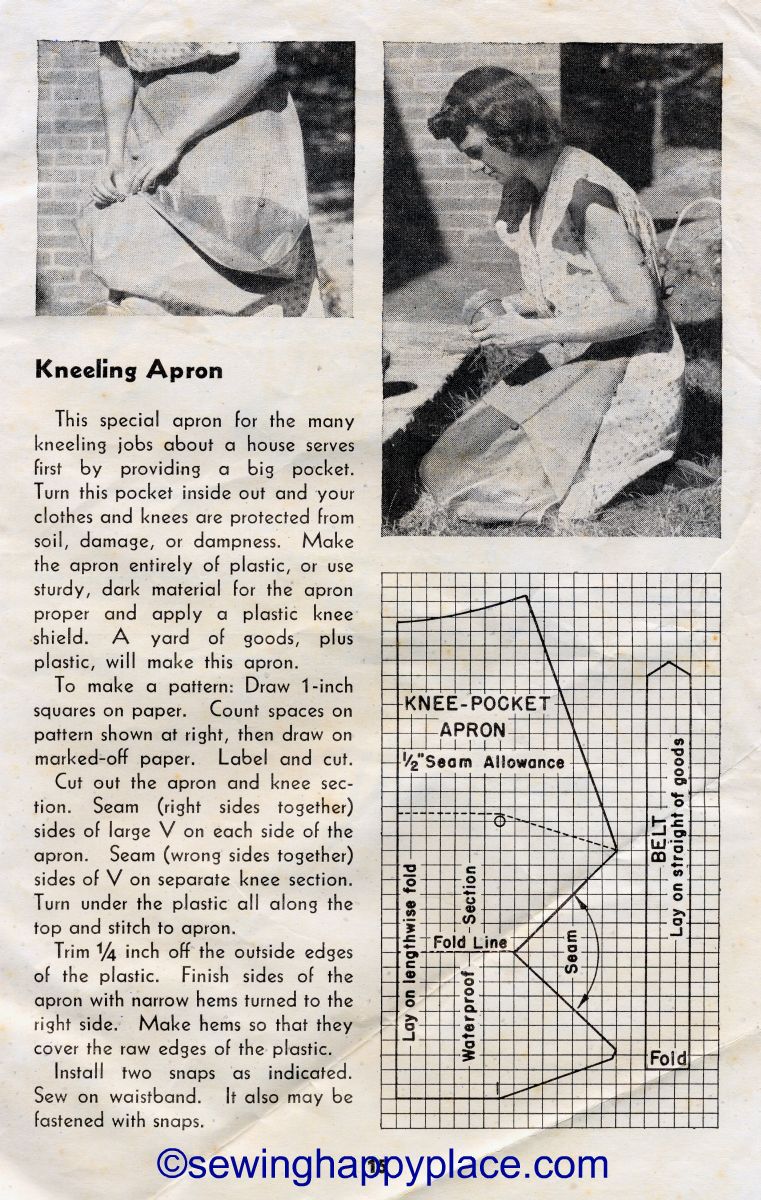
Harvesting bags

2/12/2016
An Inquiry into Tastes
As part of our third White Dinner party, I tried an experiment to get myself more familiar with the 15 modes of existence, and to discuss the idea the inquiry into these modes and their crossings.
I bought a selection of foods from Lidl, making the selection based on the idea of creating sweets. But as soon as we started tasting them in combination it became apparent that it was not going to be about building/constructing sweets, but about describing taste/texture combinations.
Each food was put into a white paper box with the mode description glued to the bottom.
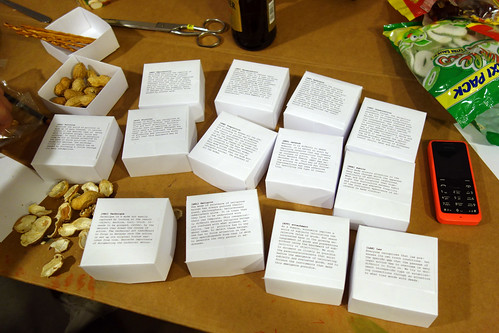
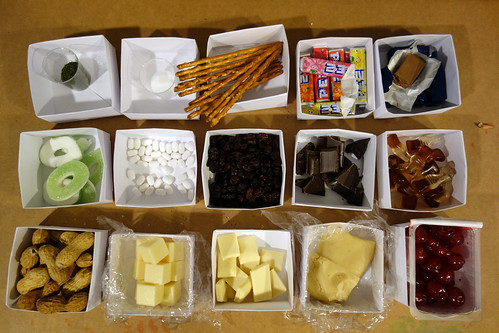
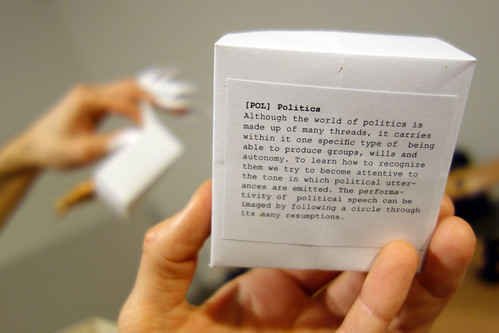
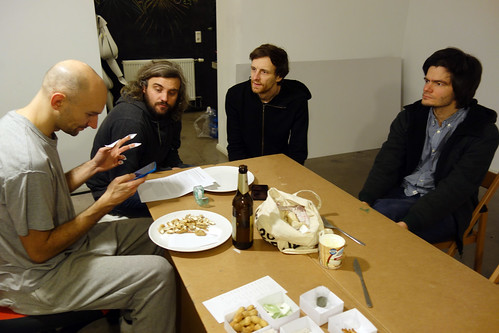
Adding cooked pasta to help make combinations. Not sure this really went anywhere.
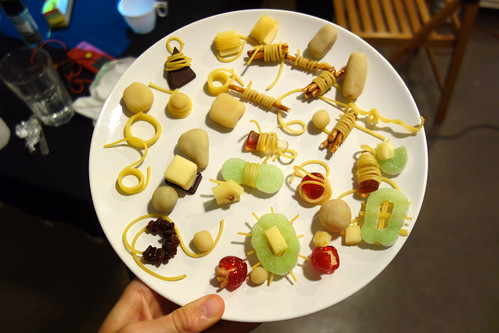
3/12/2016
Selecting Materials and Tools
Originally I imagined the selection of materials and tools for the tool kit it to have nothing to do with e-textiles, but now I find myself coming back to these materials because they so nicely allow for a cohort of raw(ish) fibers co-existing with man-made power structures.
Materials
The materials should be abundant resources, although maybe some materials could have scarcity as a property? Is it scarce in the sense of hard to get, or scarce in the sense of unsustainable? And then by abundant do I mean easy to find, or sustainable? The selection of materials should pay attention to sustainability and communicate this property of the materials as part of the kit.
The combination of materials should allow for quick and accessible making of structures/artifacts/mechanisms/circuits so that one can quickly “sketch” an idea. Quickly build an idea. A prototype. But the materials should also provide enough possibilities for endless exploration/expression. Should these materials not be all the materials? Why have a selection?
The selection of materials is made while foraging. What you find, determines what you discuss.
Notes:
– thread/sewing/tension/structures/models/sculptures…
– common/everyday/natural/materials…
Tools
Similarly can the toolkit contain any tool you want? Is the toolkit fixed? Maybe not to the exact tool, but certain tool properties which could be as broad as: additive, subtractive, manipulative…? No, the tool-kit should remain flexible, expanding to the abilities of the maker/wearer. The uniform provides a platform for making discussion, not the selection of materials and tools to discuss with, these are the choice of the maker.
2/12/2016
A Lecture on Intercessors
JB will give his lecture on intercessors – people, artefacts & machines that help us access to otherwise separated plans/dimensions.
Previously his talk titled “Morphogenesis Of The Outside” was followed by “a hands-on workshop with philosophers, dancers and artists discussing about self-reference, ontological bootstrap and high-order feedback while tinkering with electronic textile musical machines.”
Morphogenesis Of The Outside >> https://github.com/jeanbaptiste/paf/blob/master/summer2015/talk/moto.pdf
Oscillator / Resonance / Feedback Circuit Workshop >> https://github.com/jeanbaptiste/paf/blob/master/summer2015/workshop/README.md

He is also thinking about:
“material thinking” (pensée matérielle) which explores embodiment and hands-on practices as a mode of intellectual investigation.
“material ways of thinking” are a *very rich complement* to more abstract and rhetoric based argumentative settings.
11/2016
A first draft of the project description…
I find myself in the blurry midst of these two topics:
– documenting process in real-time
– physical making as a means of communication/discussion
And yesterday came to this rather simplistic proposition:
Latour defines 15 modes of existence (I am just at the beginning of understanding their definitions and crossings). Can these modes be translated into a selection of materials and accompanied by a set of tools, to provide a toolkit for further inquiry?
JB’s response: “in the same vein that a “reading group” triggers a discussion, a “making group” could do the same. but what do we make? … a miniature model / a mock-up / a demo”
A second draft…
I propose a “making discussion”. Making involves materials and tools, so I will put together a set of materials and tools. One representative material for each defined mode of existence. These materials should be abundant resources – drinking straws, napkins, leaves, string, hair, paperclips, paper, bottle tops, elastic bands, pins, gum, coins, magnets…
Tools would be chosen for the ability to modify and work these materials into combined structures.
I imagine a uniform or costume for the “inquirer into our modes of existence”. The uniform contains the tools (similar to a tool belt), and provides space for collecting and organizing the materials. And if not a uniform, then a portable tool-kit. I will make multiples of this uniform/tool-kit and participants will each wear/use one during the making discussion.
How to start a “making discussion”? Can the materials inform the content of the discussion? We could build structures that house our existence. Miniature world models. Homes. Can we talk while we make? Contradictions are a natural starting points for discussion.
Who will participate in the making discussion? Skilled makers, manipulators of material. Is there an audience?
Documentation? Real-time photo documentation via wifi directly from the camera. A camera should be integrated into each uniform – too much for this time. Maybe a central camera mounted above. A designated photo reporter?
Links and quotes:
JB’s slidedeck as a proposal to create a research lab in an art school context:
>> http://web.media.mit.edu/~labrune/talks/fablab-perspectives-l.pdf
Froebel’s Gifts:
>> https://en.wikipedia.org/wiki/Froebel_gifts
Frei Otto’s “Thinking by Modeling” exhibition at ZKM
>> http://zkm.de/en/event/2016/11/frei-otto-thinking-by-modeling
“Leibniz was interested in facilitations of thought processes by technical means and offered the procedure enabling inventors to achieve this objective: Formalisation enables the mechanisation of calculation.”
(http://dreher.netzliteratur.net/4_Medienkunst_Kybernetike.html)
“a transport without transformation”
(http://www.bruno-latour.fr/node/328)
11/2016
Starting to read Donna Haraway’s “Staying with the Trouble”.

Donna Haraway, “Anthropocene, Capitalocene, Chthulucene: Staying with the Trouble”, 5/9/14 from AURA on Vimeo.
10/2016
I forget why, but in looking for information about the book “Thousand Plateaus: Capitalism and Schzophrenia”, I came across these drawings by Marc Ngui. He writes they are methodical interpretations of the first two chapters of the book. These are visualizations of theories and concepts using markers and paper. How could something like it be done in three-dimensional, material form?
>> http://www.bumblenut.com/drawing/art/plateaus/
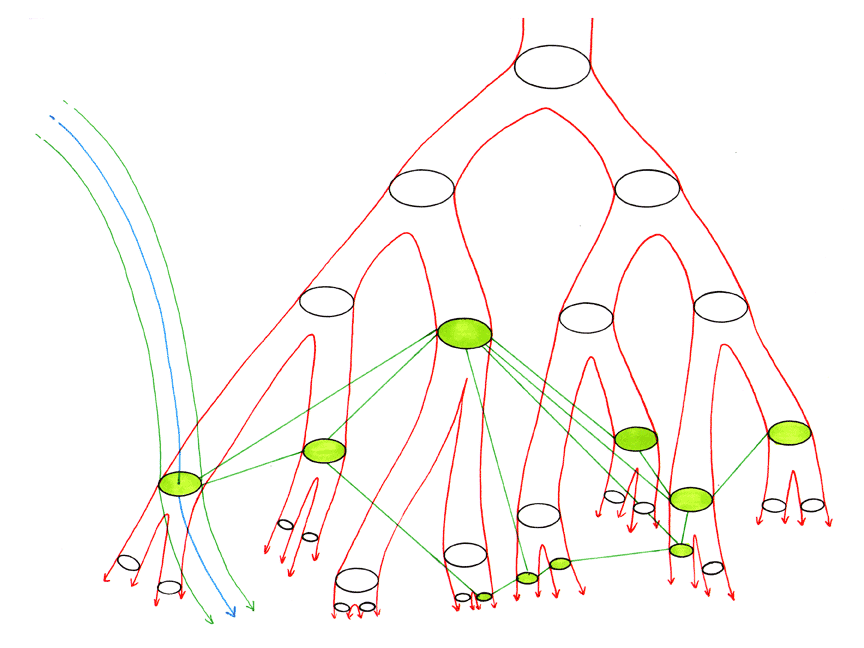
A while later I see that Haus der Kulturen der Welt is organizing a discussion series titled “Dictionary of Now”. They use an image by Nikolaus Gansterer titled “Theory Casing IV (of the Middle of the Moment)”, 2013.
Dictionary of Now >> https://www.hkw.de/en/programm/projekte/2015/woerterbuch_der_gegenwart/woerterbuch_der_gegenwart_start.php
Nikolaus Gansterer >> http://www.gansterer.org/
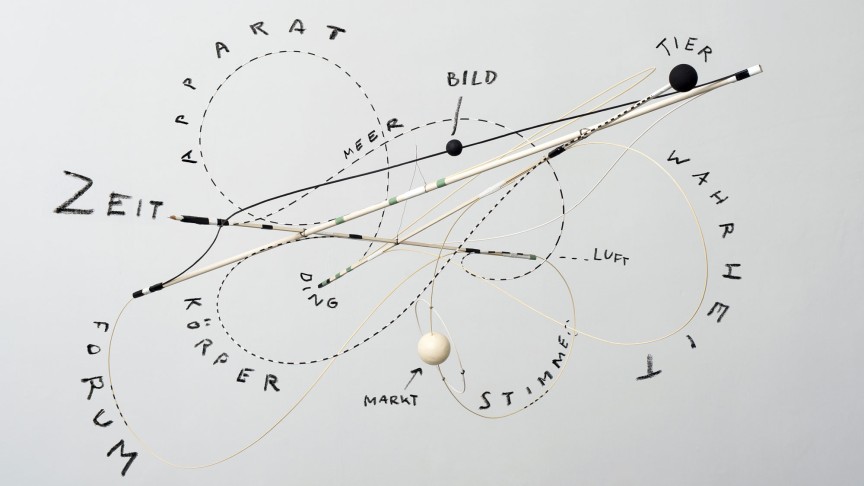
The original piece by Nikolaus Gansterer does not include the annotating text. I wonder if the text is the written interpretation of the content of the form. The content the form wants to express. His project pages says “Proxemics is the study of how individuals behave in space in terms of proximity-distance. It specifies the distances that people maintain from one another in different situations, thereby communicating with one another non-verbally.”
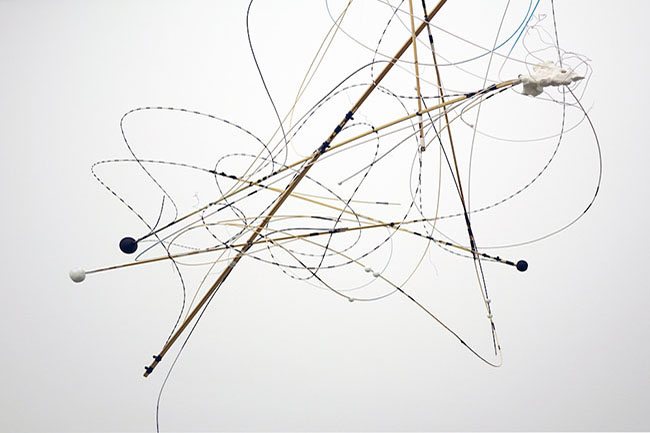
8/2016
On the Symposionista blog I discover Latour’s video “An Inquiry Into Modes Of Existence”.
For the last half year I have been attempting to read Bruno Latour’s book “We Have Never Been Modern”. Only slowly grasping the idea that after realizing we can not distinguish our time by thinking of ourselves as modern, because what we think of as modernity is not what we are, we are lacking a value system. To (re)create or begin to define our value system, we must first reset.
The video leads me to the digital platform of An Inquiry into Modes of Existence:
>> http://modesofexistence.org/
And the recent ZKM exhibition “GLOBALE: Reset Modernity!”
>> http://zkm.de/en/event/2016/04/globale-reset-modernity
>> https://www.youtube.com/watch?v=STn9DLHtoBA
And the book cover:

And to think about how I could add to this discussion through making physical artifacts. The visual representations of modes on the book cover, and the arrangement of their crossings in the triangular chart make these value entities appear tangible. If they were really tangible, what translations could be added to their discussion?
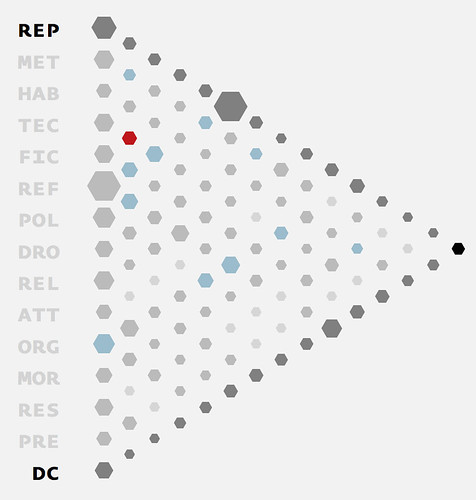
9/2016
This picture taken of an elastic band lying in a puddle on the ground, reminded me of a segmented chart. It captures both separation and overlap of objects, contents, ideas. A random shape by a specific material. Trying to create order, by just lying on the ground.
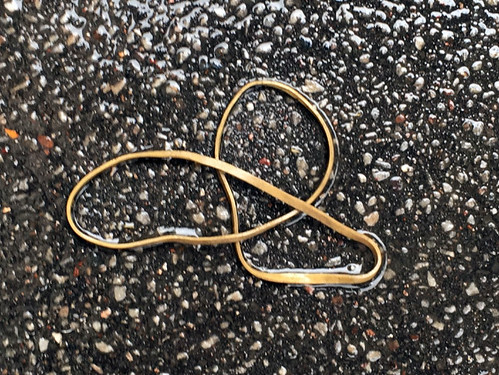
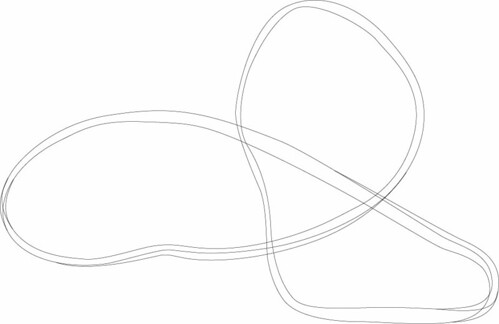
Tracing the shape and separating the segments to become entities of their own. The overlap can be assigned to part of each segment or remain a segment on it’s own.
The overlap must expand to grow beyond itself.
9/2016
An exercise in adding metadata to images…
I read about DiEM 25
>> http://nala.io/~s/_site/
>> http://diem25.org/
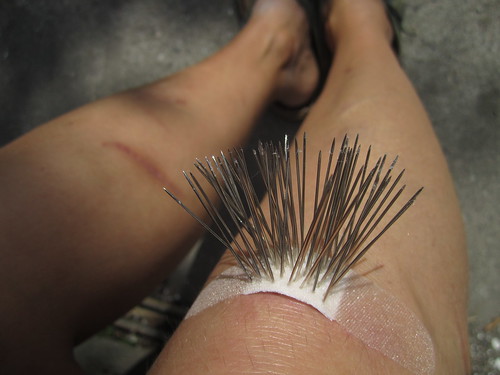
21/8/2016
Symposionista >> http://symposionista.tumblr.com/
Expose >> https://github.com/Jack000/Expose/issues
Symposionista + Expose >> http://nala.io/symposion/
Symposion: group of people come together and each of the person propose a talk but first they would drink, eat, and talk, it is open, no agenda only a conversation space to express thoughts, an incubator to initiate further thoughts.
POSSIBLE OUTCOME: A multi person, multi format, multi layered, multi platform ESSAY (essay means attempt, trial, infinite, polyperspective, collaboratively curated, subjective research, participant-dependant narrative)
MEETING PLACES: BodenSee, Brussels, Nantes, Athens, Stuttgart, Paris, PAF…
